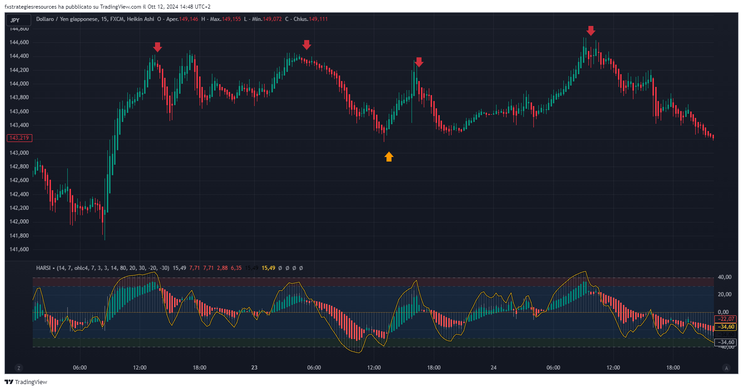109# How To Trade With HARSI - Basic Tutorial -
Submit by Maximo trader.
Indicator Descriptions:
-
HARSI Indicator:
-
The HARSI combines RSI (Relative Strength Index) with Heikin-Ashi candles to reduce market noise and highlight trends.
-
Upper Zone: When the HARSI reaches the overbought (OB) level, typically above 20 (e.g., 30), a price reversal is expected.
-
Lower Zone: When the HARSI reaches the oversold (OS) level, typically below -20 (e.g., -30), a potential price increase is anticipated.
-
HARSI Reversal Trend Strategy
Indicator Setup:
-
HARSI Upper Zone: Overbought level (e.g., 20 or 30).
-
HARSI Lower Zone: Oversold level (e.g., -20 or -30).
-
Candles: Heikin-Ashi candles are used for trend analysis, with colors indicating momentum shifts.
Long (Buy) Setup:
-
Oversold Zone: The HARSI candles must touch or dip below the lower zone (below -20 or -30).
-
Candle Reversal: Wait for the first candle to change from red to green, indicating a potential reversal and bullish momentum.
-
Entry: Enter a long position when the candle closes green after touching the lower zone.
-
Exit: Close the position when the HARSI candles approach the upper zone (overbought area), or when a candle turns red, signaling a reversal in momentum.
Short (Sell) Setup:
-
Overbought Zone: The HARSI candles must touch or exceed the upper zone (above 20 or 30).
-
Candle Reversal: Wait for the first candle to change from green to red, indicating a potential reversal and bearish momentum.
-
Entry: Enter a short position when the candle closes red after touching the upper zone.
-
Exit: Close the position when the HARSI candles approach the lower zone (oversold area), or when a candle turns green, signaling a reversal in momentum.
Risk Management:
-
Stop-Loss: Place a stop-loss just beyond the previous high or low to manage risk.
-
Take-Profit: Use support and resistance levels or wait for HARSI to signal the opposite zone to close the trade.
This strategy leverages HARSI's ability to smooth market noise while identifying trend reversals based on overbought and oversold conditions.








